A mixed-bag adventure at Highland Hills Ranch
You have to really want to get to Highland Hills Ranch.
For someone from the East Coast, the journey begins with a cross-country flight—traversing four time zones—to Portland, Oregon. There you transfer to a rental car for a drive backtracking east. At first the route takes you along Interstate 84, snaking through the vast Columbia River Gorge, but after two hours you exit onto the sinuous Route 19 South, complete with hairpin curves edged by skinny shoulders and steep drop-offs. At one point you cross the Oregon Trail before passing fields of windmills that appear to have sprung up like sunflowers. Eventually you turn onto Upper Rock Creek Road, which shortly becomes gravel and winds through basalt canyons and past the occasional hayfield. Ten miles in you take a left onto Wolf Hollow Lane and then an immediate right past a stone monument that informs you you’ve reached your destination.
But it isn’t until you pass through the Highland Hills Ranch gate and proceed up the drive that you know you’re where you’re supposed to be. That’s when you begin seeing signs that you’ve entered a high-desert oasis—like plush irrigated cropfields and sidehill orchards. And birds! Long-tailed pheasants strutting haughtily across the road and coveys of chukars and Huns scurrying through the brush. Eventually you spy the imposing lodge nestled up-valley and head for “home.”

I made my trek to Highland Hills this past October, just as the hunting season was ramping up, and after a long day of travel pulled into the parking lot in late afternoon. There I was greeted by Mindi Macnab, who, together with her husband, Dennis, owns the ranch. Mindi escorted me into the palatial log lodge and showed me to my room, where I stowed my bags and freshened up.
Following a tour of the lodge—a 10,000-square-foot structure that, despite its size, is laid out and decorated in a way that makes it feel homey—I was given two options: join some of the other guests on the sporting clays course or relax on the deck with a cocktail. Hmm. “Option B, please.”
In truth, it was a no-brainer. Let’s just say that the commanding views that unfold from Highland Hills’ deck are meant to be savored. Feet up, drink in hand, my eyes drifted from the distant round hilltops to the irrigated fields below. And what’s that? Roosters chasing and sparring at the edge of the lawn where grass gives way to cover. Quite the welcoming committee.
That evening at the communal dinner table we were joined by Dennis Macnab, who as a pre-hunt custom asked the guests to go around the table and introduce themselves. Come to find out I was dining with a diverse group that included a retired restaurateur and his son; a lawyer turned winery owner; five employees of a drilling company; and a Realtor, her son and her son-in-law. Almost all had been to the lodge previously, and several said that their return felt like “coming home.”

The next morning after breakfast we gathered in the gunroom, where we were given a safety talk by Dennis before scattering to various parts of the ranch for the morning hunt.
Being that I was a party of one, Dennis offered to join me, and we jumped in a truck and headed for the hills. Literally. The layout at the ranch is such that the lodge sits halfway up a valley hemmed in by high bluffs, with the valley floor traversed by a creek and dotted with cropfields. The different habitat types host different gamebirds—the hilltops and intermittent draws covered up in chukars; the low-lying fields teeming with pheasants, Hungarian partridge, chukars and bobwhite and valley quail.
When we topped out on one of the bluffs, it definitely felt like we were in chukar country. The vast open area was overspread with bunchgrass and sagebrush, the hills giving way to deep draws sprinkled with shale ledges. And the view was spectacular, with Mount Hood to the west, the Blue Mountains to the east and the colorful, fertile valley below.
Our guide was Kyle Hinton, a dog breeder and trainer from Mississippi, and we set off behind two of his shorthairs with an English cocker at heel. For the next two hours the dogs led us around the hills, eating up ground and sticking covey after covey. Each time the shorthairs would go on point, Dennis and I would walk in and get in position, and then Kyle would release the little brown grenade, who would spring into the grass, blow out the birds and then ferret out the fallen and bring them to hand. I lost count of how many coveys we found, but I can tell you that the two dozen chukars bagged were just a fraction of those we saw.
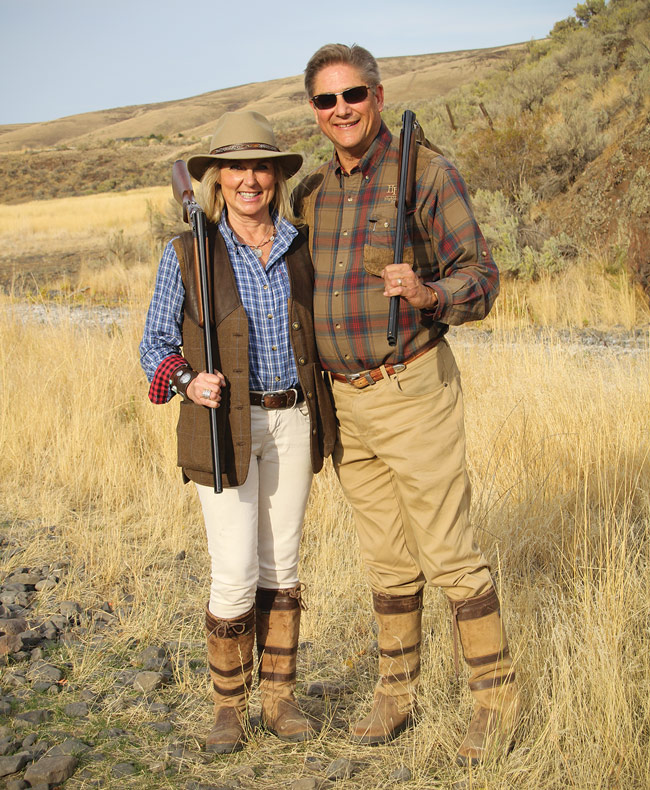
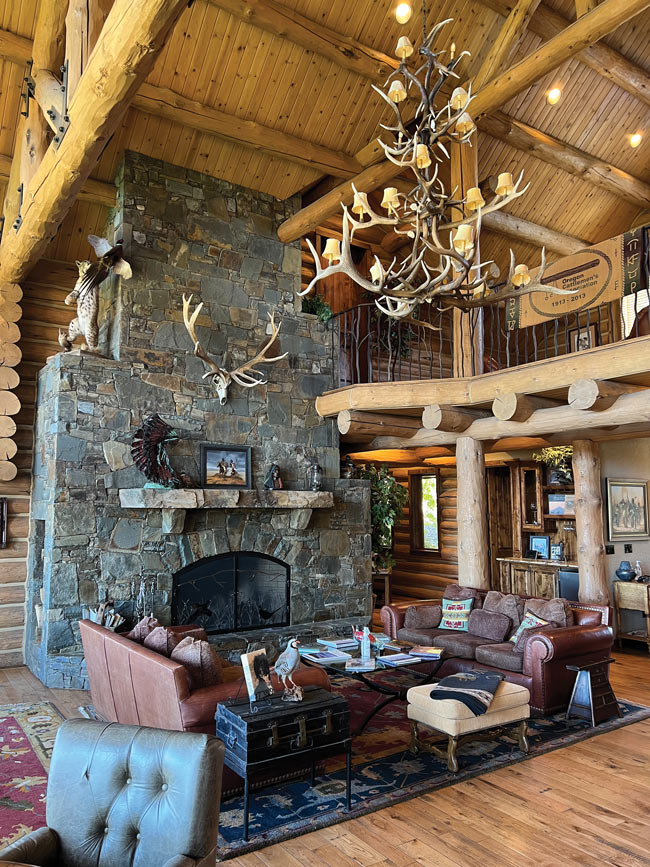
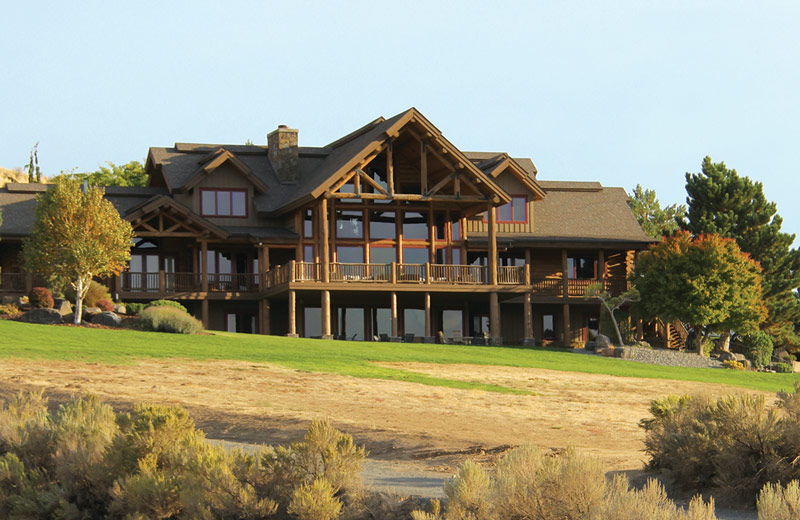
On the trip back to the lodge I asked Dennis how he’d gotten to this part of Oregon and started Highland Hills. It turns out that during the Reformation his ancestors had emigrated from Scotland to Canada, and then in the late 1800s had moved south to Oregon, where they’d homesteaded on four sections of land one county over from where the ranch is. Dennis had grown up on the family farm hunting deer and pheasants, and then had gone to dental school and started a practice. Eventually he’d decided that he wanted a spread of his own, and he’d begun looking for a place that met four criteria: great bird hunting, water going through the middle, enough acres so “you felt like you had something” and irrigation. A 3,000-acre cattle-and-alfalfa ranch in the town of Condon checked all the boxes.
Sending in the cockers was like dropping a cluster bomb.
Dennis bought the place in 1996 and immediately removed the cattle and began enhancing the bird habitat. He even went to the extreme of fertilizing the grasslands on the surrounding hills for the chukars and mule deer. With the original vision for the property being to host dental continuing-education programs around hunting, he decided to “build it and they will come”—“it” being the custom log lodge, which was completed in 2002. In the end, however, he hosted only one seminar before switching gears to focus on running the lodge as a straight bird hunting operation. And he never looked back. (“Well, maybe a few times,” but never for long . . . .)
Following lunch and a siesta, Dennis and I were joined by Mindi for the afternoon hunt. This time we remained low, plying some of the fields that dot the valley. We worked along the fringes of Rock Creek, which while I was there was a “creek” in name only—the dry bed and occasional pool belying the torrent it becomes with spring’s snowmelt.
Kyle’s shorthairs put on another great performance, striking point after point in the milo and brushy edges, and we shot the variety of birds that Highland Hills is known for. In fact, had I not whiffed on a covey of bobwhites, I would have had what the ranch calls the “grand slam”: a pheasant, chukar, Hun and quail all in the same day.
Flushing and retrieving duties that afternoon fell to several of Mindi’s English cockers—dogs that she has been sourcing in the US and UK with plans to begin a breeding program. Watching the little fireballs in the field and having seen their relaxed demeanors at the lodge, I easily understood why many people already had expressed interest in pups.
With the birds piling up and the shadows lengthening, we loaded into the truck and headed for home. En route Dennis pointed out a series of basalt cliffs where driven shoots take place. Guns are situated at pegs along the bases of the cliffs over which pheasants present themselves at heights of up to 50 yards. Three, 300-bird drives make for a challenging, hot-barreled shoot.
That evening we were treated to a fabulous dinner of filet mignon followed by key lime pie, and then partook in cognac and cigars by the firepit as we gazed up at an endless vault of stars. It was a wonderful end to a spectacular day.
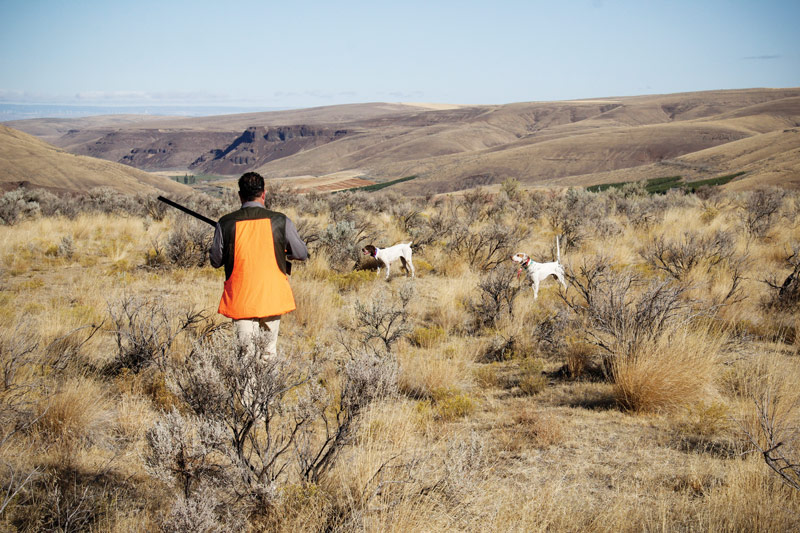
The next morning I traded my gun for my camera and tagged along with two hunters from the drilling company and guides Tyler Biggs and Kyle. We returned to the high country, where cool temperatures and clear skies promised great scenting and walking conditions. The guns were still being pulled from their cases when the first dog went on point, and from there it was game on—the composed pair of a pointer and shorthair leading us through the hills, where chukars were spread out in singles, pairs and coveys of up to a half-dozen. Had the shooting performances been better, we could have filled the truck bed with birds; but more importantly the hunters enjoyed almost nonstop action amidst the breathtaking scenery.

Similarly in the afternoon there were innumerable birds seen and shot at, although this time I was following three guests in a large pivot field in the valley. True to a lowland hunt, the birds were a mix of pheasants, Huns, chukars and quail—and, yes, the crew combined on a grand slam.
Especially fun was that we were hunting with a veritable riot of dogs, including a couple of shorthairs, a Brittany and three cockers. It was basically controlled chaos, with the pointing dogs vacuuming up scent, and the cockers resembling breaching dolphins as they bounded through the milo to flush what had been pointed. At times it felt like we were chasing birds around a track, as pheasants could be seen sprinting ahead in the cut paths; but the idea of setting out blockers was dismissed when we realized how futile it would have been in such a vast field.
Clockwise from left: Guide Kyle Hinton readies one of his shorthairs for the hunt; walking a high-country hill; a chukar flushes from the sage; working the lowlands with a riot of dogs.
The day ended on a high note, with the shorthairs pinning a large covey of Huns as we neared the trucks. Sending in the cockers was like dropping a cluster bomb, and the flush that resulted was a fitting grand finale.
That was my last hunt of the trip, and the following morning I began my cross-country trek home. Ironically, one of the most difficult legs was simply getting to the end of the ranch’s drive, as I had to stop so often to avoid running down roosters and to allow coveys of chukars and Huns to cross. It almost felt like a sign that I should turn around, though I knew there was no need to prolong my stay. I’d already promised myself that I’d be heading back to Highland Hills soon enough.
Buy This Issue!
Read our Newsletter
Stay connected to the best of wingshooting & fine guns with additional free content, special offers and promotions.






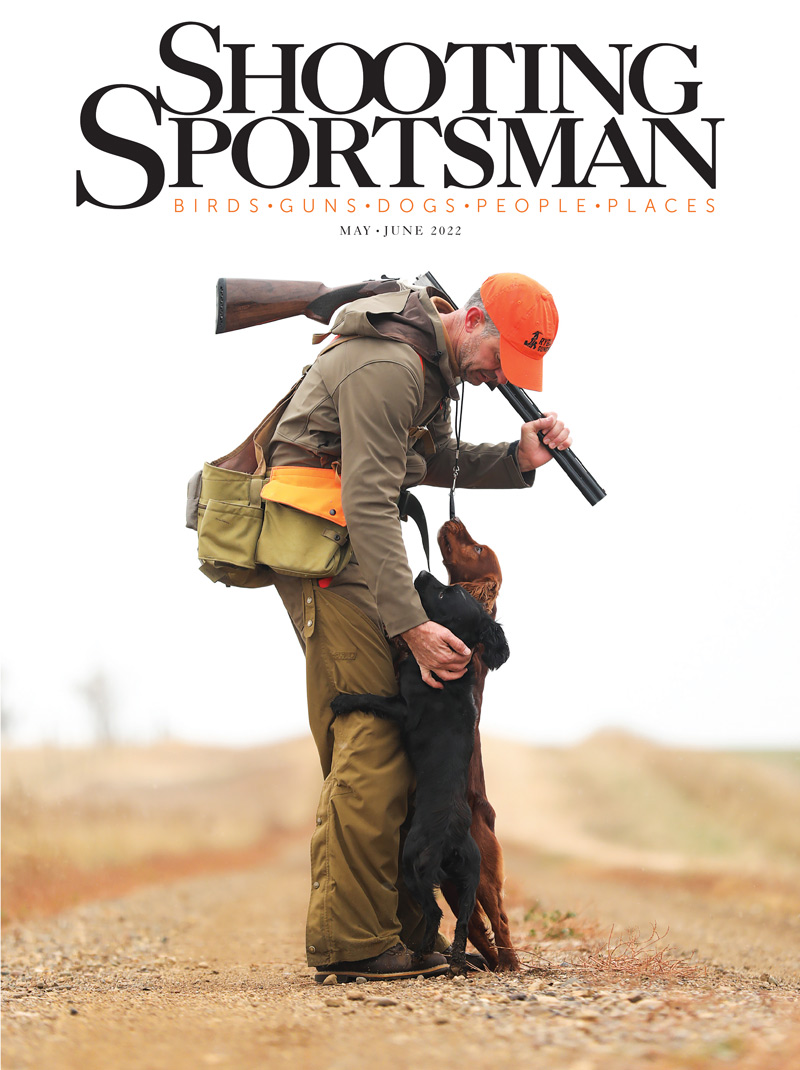



Ralph, good review. Nice people.